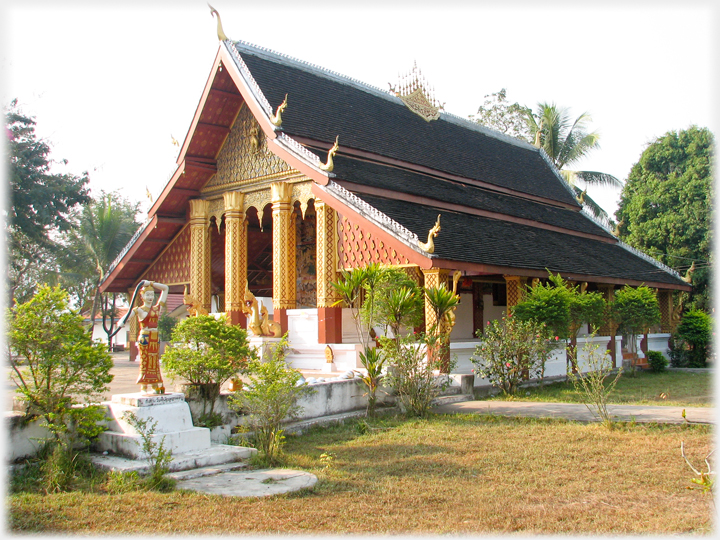 The Wat Ho Siang has twenty or more resident monks, nuns and novices. It was founded at the start of the eighteenth century and, like many of the pagodas in Luang Prabang, has undergone many rebuildings since then. The unusual octagonal pillars were added in 1973.
This is the second page on the town of Luang Prabang, images of pagodas were omitted from the last page and are now assembled below. The word 'wat' (sometimes 'vat') is used in Laos where pagoda is used in Vietnam meaning a Buddhist institution, however, the word 'wats' is clumsy and so here pagoda is sometimes used. They form, not only the crowning glory of an already well endowed town, but the pagodas of Luang Prabang define a key element of Laos architecture to such an extent that it is known as the "Luang Prabang Style". This style consists essentially in exuberant ornamentation, and the extraordinary 'floating' roofs that can be seen on the pagodas, these may have up to seven layers stacked one on top of the other. For more details there is a very
rich and informative website
The Wat Ho Siang has twenty or more resident monks, nuns and novices. It was founded at the start of the eighteenth century and, like many of the pagodas in Luang Prabang, has undergone many rebuildings since then. The unusual octagonal pillars were added in 1973.
This is the second page on the town of Luang Prabang, images of pagodas were omitted from the last page and are now assembled below. The word 'wat' (sometimes 'vat') is used in Laos where pagoda is used in Vietnam meaning a Buddhist institution, however, the word 'wats' is clumsy and so here pagoda is sometimes used. They form, not only the crowning glory of an already well endowed town, but the pagodas of Luang Prabang define a key element of Laos architecture to such an extent that it is known as the "Luang Prabang Style". This style consists essentially in exuberant ornamentation, and the extraordinary 'floating' roofs that can be seen on the pagodas, these may have up to seven layers stacked one on top of the other. For more details there is a very
rich and informative website
 with scores of photographs of about 28 of the pagodas which contribute to the town's beauty. This page features just six of those, plus one they do not list.
with scores of photographs of about 28 of the pagodas which contribute to the town's beauty. This page features just six of those, plus one they do not list.
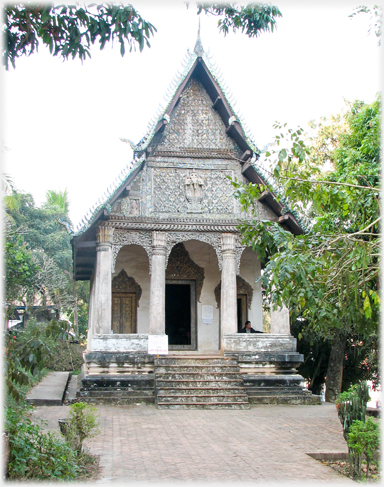 And to start an example lacking that profuse ornamentation just mentioned, the Wat Pa Huak dates from 1861. Since this photo was taken it has received a full make over, and is now as resplendent as any of its 'rivals'.
And to start an example lacking that profuse ornamentation just mentioned, the Wat Pa Huak dates from 1861. Since this photo was taken it has received a full make over, and is now as resplendent as any of its 'rivals'.
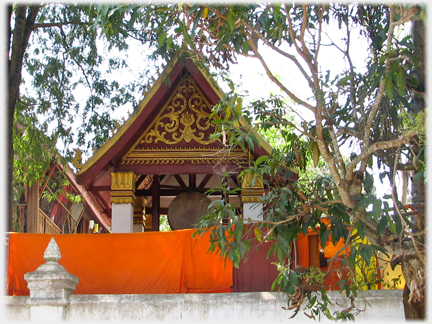 Monks robes drying in front of a gong house
Monks robes drying in front of a gong house
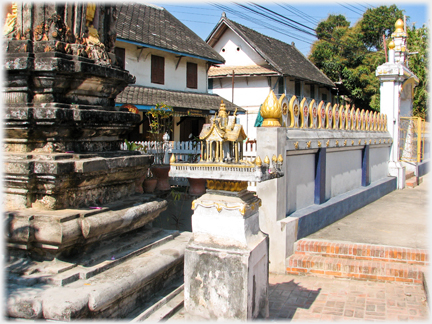 A model Luang Prabang pagoda on an altar by a stupa
A model Luang Prabang pagoda on an altar by a stupa
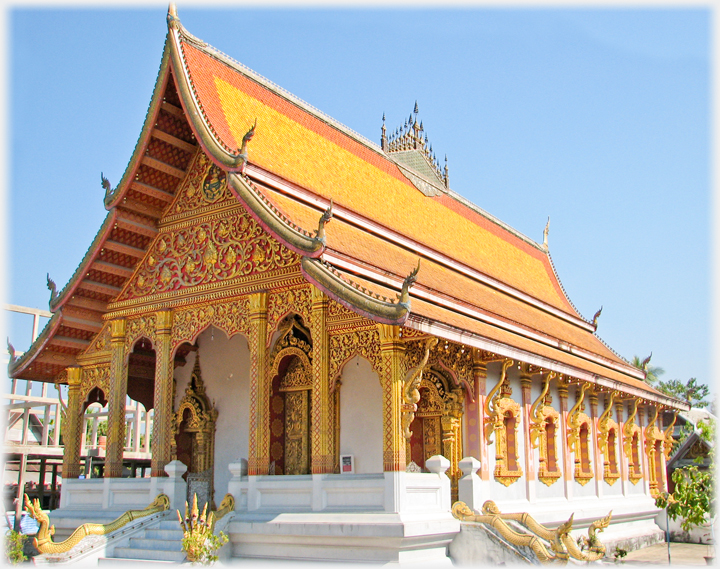 This is the splendid Wat Nong Sikhounmuang which is a curious omission from the otherwise comprehensive catalogue just mentioned on the Oriental Architecture website
This is the splendid Wat Nong Sikhounmuang which is a curious omission from the otherwise comprehensive catalogue just mentioned on the Oriental Architecture website
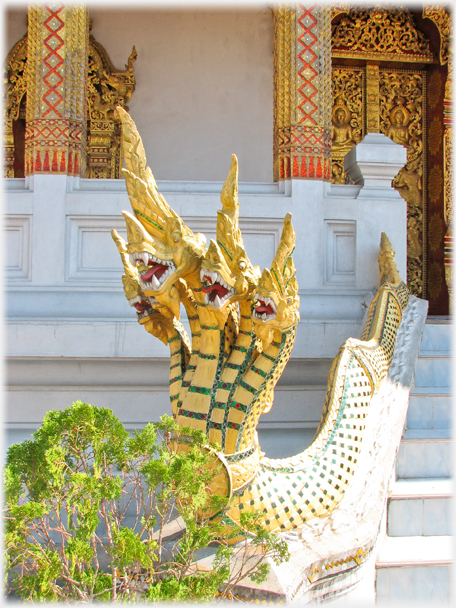 One of the Nagas - part human and part serpent - that defend the entrance and corners of the Wat Nong Sikhounmuang
One of the Nagas - part human and part serpent - that defend the entrance and corners of the Wat Nong Sikhounmuang
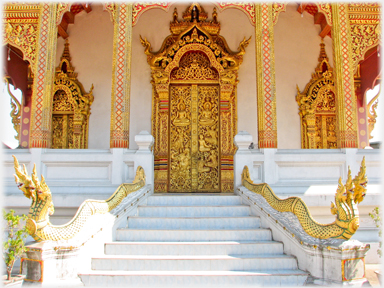 The Pagoda's entrance steps with
The Pagoda's entrance steps with
two guarding Nagas The Wat Nong Sikhounmuang was built in 1729, razed by fire in 1774, rebuilt in 1804, and again so damaged by bad weather it had to be rebuilt after 1965. Its rebuilding has meant it is said to have strong Thai influences in its ornamentation. Indeed the Nagas are common in Thailand.
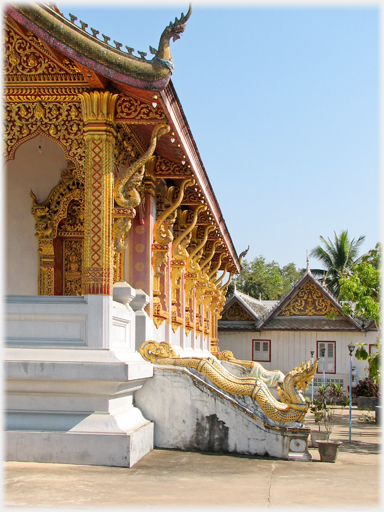 The heavily ornamented side of the main building...
The heavily ornamented side of the main building...
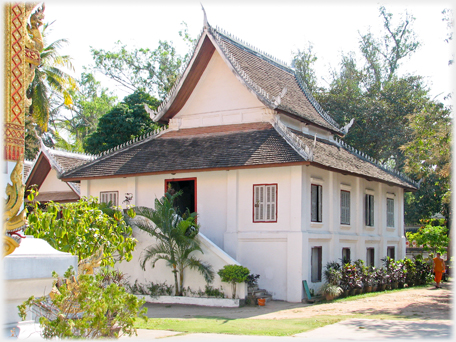 A plainer building, but with double roof, across the courtyard
A plainer building, but with double roof, across the courtyard
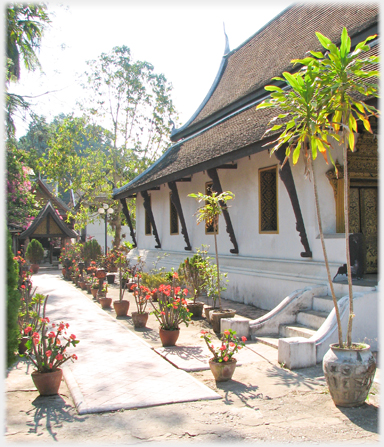 ...and, by contrast, here on the Choum Khong, a plain un-gilded side wall, although again supporting a two-layered roof
...and, by contrast, here on the Choum Khong, a plain un-gilded side wall, although again supporting a two-layered roof
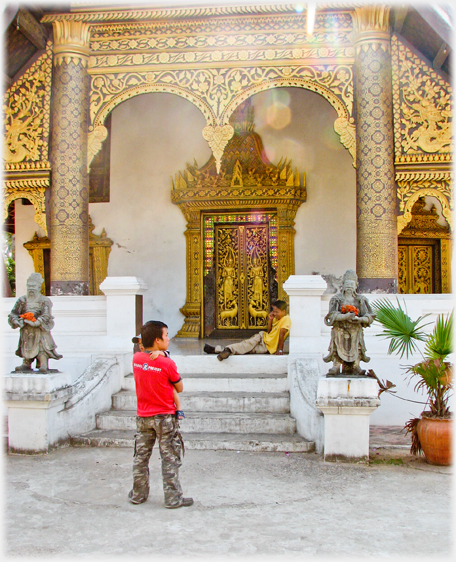 Above is the entrance area and steps of the Wat Choum Khong. This pagoda cum monastery shares the common history in Luang Prabang of repeated rebuilding. Originally built in 1843 it was restored or re-built in 1933, 1951 and 1962. One contributory explanation for this widespread short shelf life of Luang Prabang Pagodas is the easy availability of wood in Laos. But thereafter the tropical climate is not always kind to wood.
Above is the entrance area and steps of the Wat Choum Khong. This pagoda cum monastery shares the common history in Luang Prabang of repeated rebuilding. Originally built in 1843 it was restored or re-built in 1933, 1951 and 1962. One contributory explanation for this widespread short shelf life of Luang Prabang Pagodas is the easy availability of wood in Laos. But thereafter the tropical climate is not always kind to wood.
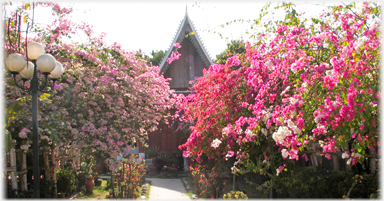
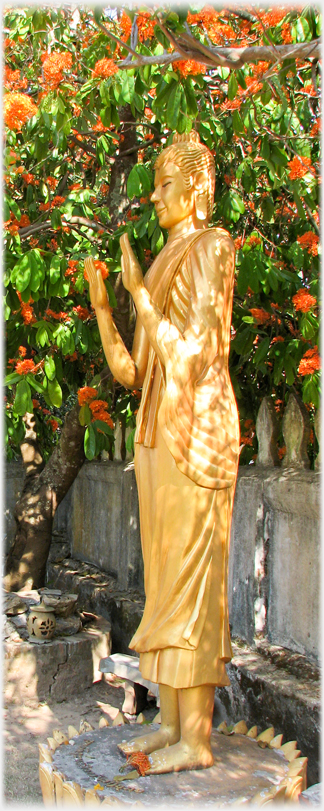 And above, in the well kept gardens of the Choum Khong, a reminder of non-architectural delights. To the right, a standing gold Buddha is part of a small group of statues in a garden, but my infirm memory is not sure if it was in the above garden, or that belonging to the Xieng Mouane below.
And above, in the well kept gardens of the Choum Khong, a reminder of non-architectural delights. To the right, a standing gold Buddha is part of a small group of statues in a garden, but my infirm memory is not sure if it was in the above garden, or that belonging to the Xieng Mouane below.
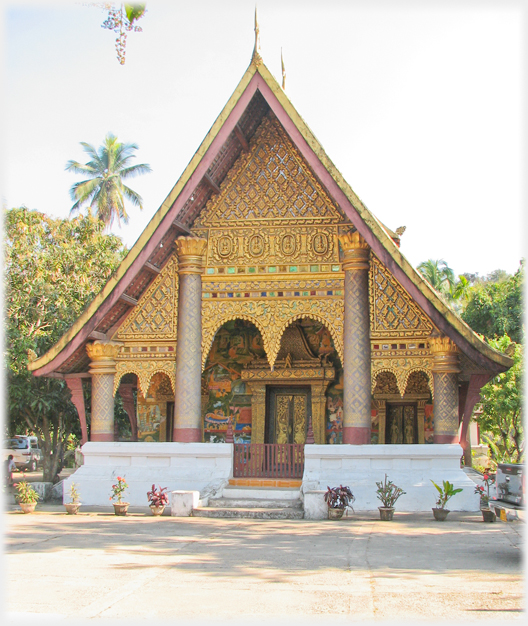 The Wat Xieng Mouane dates from the latter part of the nineteenth century and is now a centre for various crafts associated with the restoration and preservation of these buildings
The Wat Xieng Mouane dates from the latter part of the nineteenth century and is now a centre for various crafts associated with the restoration and preservation of these buildings
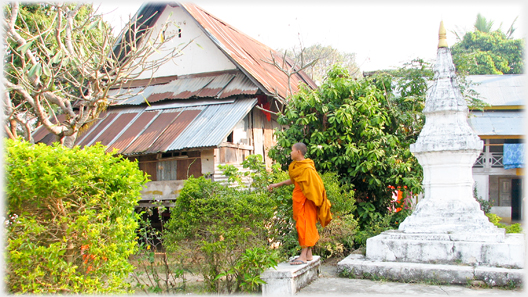 Above and below: two contrasting roofs
Above and below: two contrasting roofs
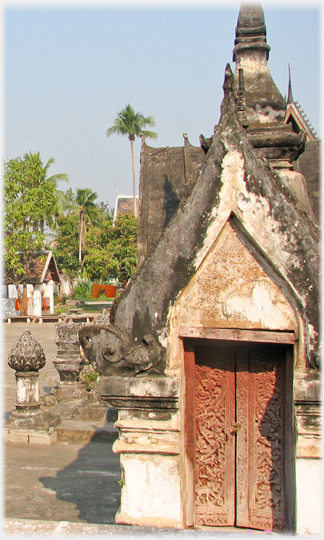 To the left, the main buildings; above and below, a small chapel in the grounds of Wat Mai, the roof of which echoes the overlaps and 'finials' of the main building
To the left, the main buildings; above and below, a small chapel in the grounds of Wat Mai, the roof of which echoes the overlaps and 'finials' of the main building
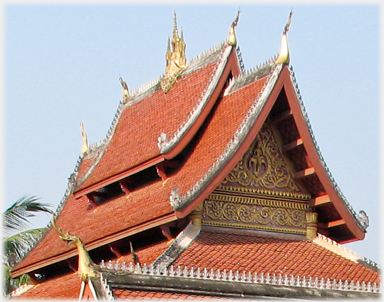 Closer view of the main roof of the Wat Mai
The Wat Mai (confusingly not the only 'New Pagoda' in Luang Prabang) is part of an extensive monastery which contributed a number of photos to the
'Monks' page.
Closer view of the main roof of the Wat Mai
The Wat Mai (confusingly not the only 'New Pagoda' in Luang Prabang) is part of an extensive monastery which contributed a number of photos to the
'Monks' page.
 It was founded in the late eighteenth century.
It was founded in the late eighteenth century.
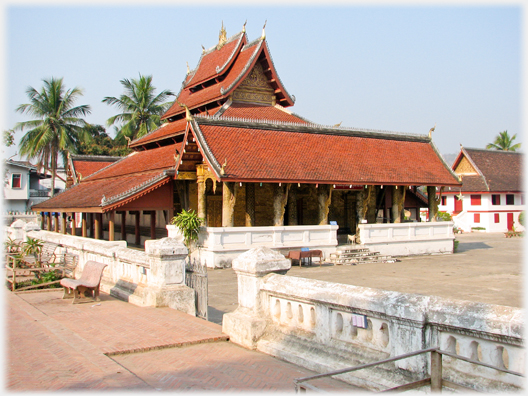
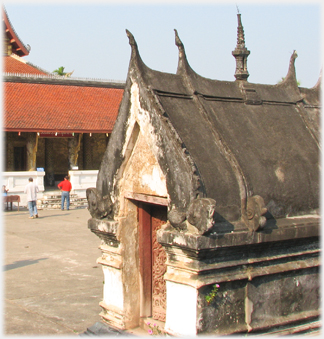
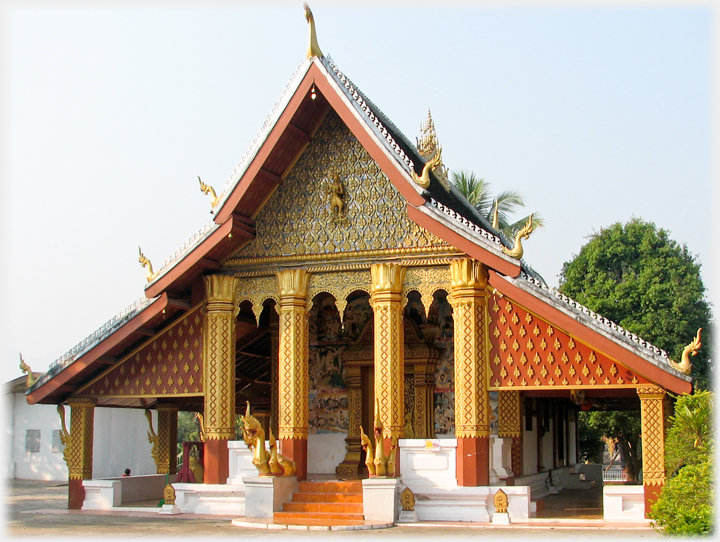 A second appearance of the Wat Ho Siang showing a little more of the wall in the entrance
A second appearance of the Wat Ho Siang showing a little more of the wall in the entrance
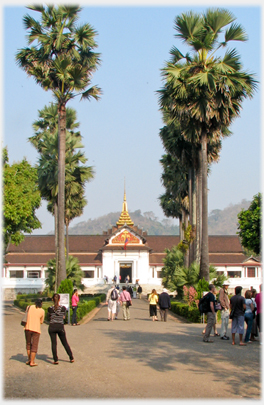 The royal palace museum...
The royal palace museum...
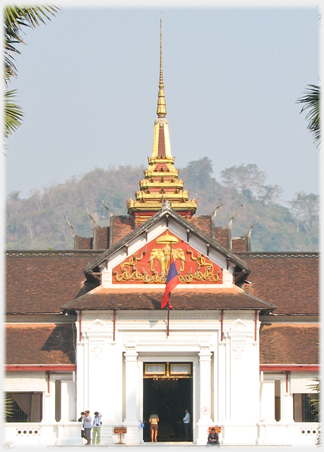
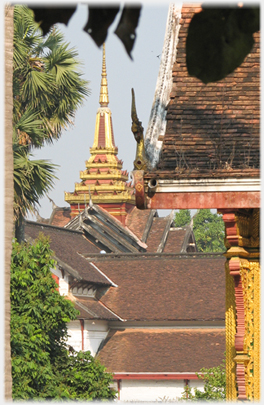 ...with its pinnacle atop the roofs
...with its pinnacle atop the roofs
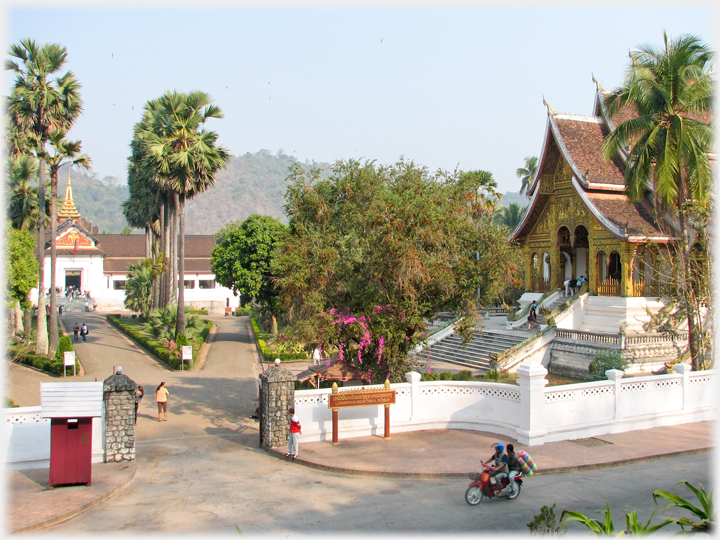 To the left, the Royal Museum, previously the palace, and to the right, the Haw Pha Bang Chapel
To the left, the Royal Museum, previously the palace, and to the right, the Haw Pha Bang Chapel
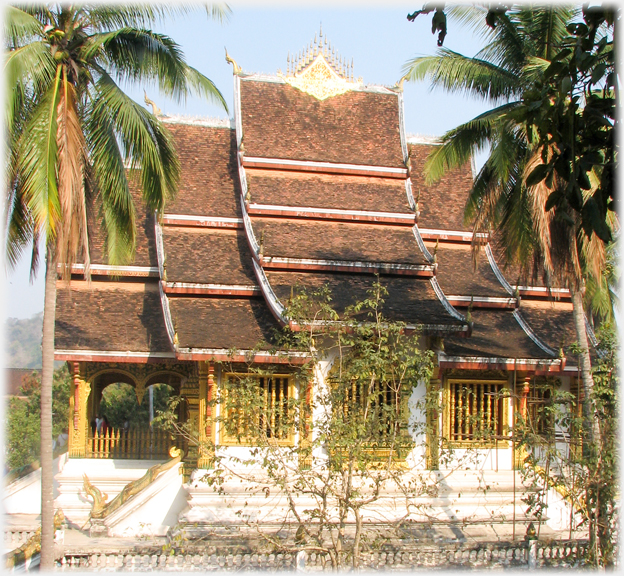 These magnificent roofs are modern, for the Haw Pha Bang building is not old. It was started in 1963 to house the gold Pha Bang statue of a standing Buddha. But due to the complex political situation of the period, the building was not finally completed, and the statue installed, until 2013
These magnificent roofs are modern, for the Haw Pha Bang building is not old. It was started in 1963 to house the gold Pha Bang statue of a standing Buddha. But due to the complex political situation of the period, the building was not finally completed, and the statue installed, until 2013
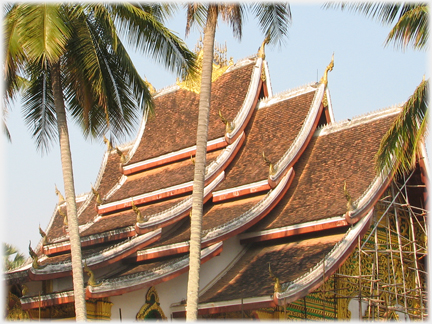 The Pha Bang Statue came to Luang Prabang in the fourteenth century when the town was the capital of the kingdom of Lan Xang. Its significance...
The Pha Bang Statue came to Luang Prabang in the fourteenth century when the town was the capital of the kingdom of Lan Xang. Its significance...
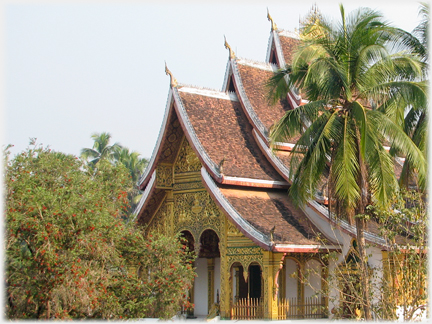 ...was so great that its name was adopted for the capital - Prabang. Pha, Phra and Pra are all ways of transliterating the first part of the name of the statue
...was so great that its name was adopted for the capital - Prabang. Pha, Phra and Pra are all ways of transliterating the first part of the name of the statue
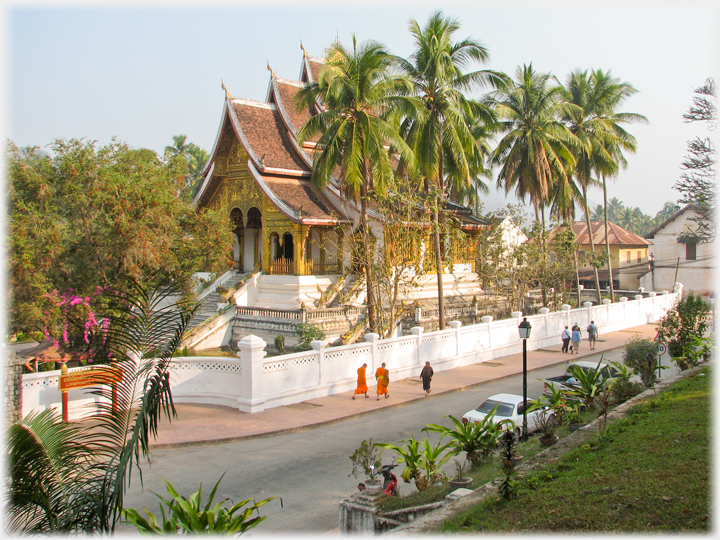 The Haw Pha Bang sits beside Sisavangvong Road, the town's main road, and provides Luang Prabang's version of a seething metropolitan hub
Trailers...
The Haw Pha Bang sits beside Sisavangvong Road, the town's main road, and provides Luang Prabang's version of a seething metropolitan hub
Trailers...
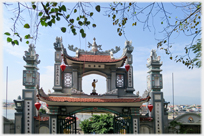 The next page
takes you to a very different genre of pagoda, the Chùa Đót Tiên in Tĩnh Gia, Vietnam.
The next page
takes you to a very different genre of pagoda, the Chùa Đót Tiên in Tĩnh Gia, Vietnam.
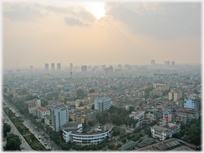 The next page
of the Mosaic Section is headed 'Against Nature'.
The next page
of the Mosaic Section is headed 'Against Nature'.
Or go to the contents of the Mosaic Section.

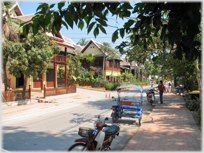 The last page, with not a pagoda in sight, pictures from Luang Prabang
The last page, with not a pagoda in sight, pictures from Luang Prabang
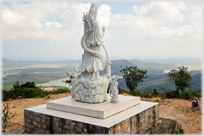 To a pagoda on a hill in Tĩnh Gia, Vietnam
To a pagoda on a hill in Tĩnh Gia, Vietnam
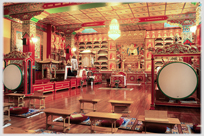 To a Buddhist institution in Southern Scotland
To a Buddhist institution in Southern Scotland
 ...guide to this site
...guide to this site